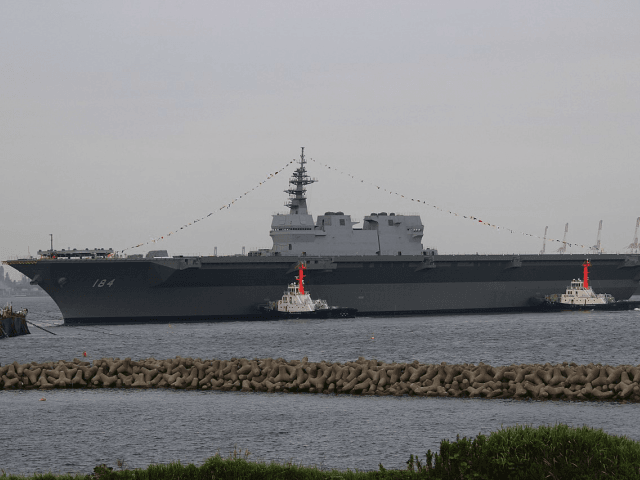The Japanese helicopter carrier Kaga visited Sri Lanka over the weekend, calling on a port that was developed with Japanese financial assistance while the people and government of Sri Lanka are questioning the wisdom of becoming more deeply indebted to China.
The Japanese made no bones about the purpose of Kaga’s visit.
“Japan’s government is promoting a free and open Indo-Pacific and this deployment in the Asia Pacific is a component of that strategy. Maritime security and stability is of critical importance,” said the ship’s commanding officer, Rear Admiral Tatsuya Fukuda.
Reuters reported on Monday that Sri Lanka welcomed the Kaga, while Chinese forces watched the passage of Japan’s largest warship and its destroyer escort with suspicion:
On its way to Sri Lanka, the 248 meter (814 ft) ship was shadowed by Chinese frigates in the South China Sea and carried out naval drills in the Philippines and Indonesia. It also drilled with a British Navy frigate before docking in Colombo on Sunday with 500 sailors and four submarine hunting helicopters aboard.
As part of the goodwill visit, the Kaga’s crew also brought packets of colorful origami paper, crafting flowers for local children who came to tour the ship soon after it docked.
The visit was intended to reassure Sri Lanka of Japan’s willingness and capability to dispatch its most powerful military assets to a region where China is growing in influence.
“Sri Lanka, as a hub in the Indian Ocean, and upholding its commitment to a free and open Indian Ocean, welcomes naval vessels from all our partner nations, to interact with Sri Lanka’s Navy,” said Sri Lankan foreign ministry spokeswoman Mahishini Colonne. “Several navy vessels from our partner countries have visited Sri Lanka this year already and the ship from Japan, a close bilateral partner, is welcomed in the same spirit.”
Reuters quoted members of the Kaga crew remarking on the unusual nature of their two-month deployment for training and gunboat diplomacy. Critics of Abe’s approach worry that he is making commitments Japanese naval forces would be hard-pressed to keep.
Japan dispatched several top officials to Sri Lanka this year, including Foreign Minister Taro Kono, and hosted Sri Lankan President Maithripala Sirisena in Tokyo for talks with Prime Minister Shinzo Abe in March. Abe is working overtime to assure allies and trading partners that Japan will be able to project enough military power to ensure their security since his recent re-election makes pro-military changes to Japan’s constitution highly likely. There are rumors Japan will develop a proper aircraft carrier over the next five years and/or VTOL jets that could be launched from the existing helicopter carriers.
Over the summer, Japan donated two coast guard ships worth about $11 million each to Sri Lanka and stepped up its efforts with India to develop an “Asia Africa Growth Corridor” that would compete with China’s Belt and Road infrastructure project.
During President Sirisena’s visit to Tokyo, he and Prime Minister Abe agreed to work together on maritime law enforcement and infrastructure development. Abe pledged $100 million in low-interest loans to Sri Lanka to develop medical facilities.
Sri Lanka finds both Beijing and Tokyo keenly interested in its strategically located ports. China grabbed the port of Hambantota by getting Sri Lanka impossibly deep in debt and agreeing to take control of the facility for a hundred years or so as partial repayment. Japan is looking at the deep-water port of Trincomalee, whose importance is keenly appreciated since Imperial Japan attacked it with kamikaze pilots when the British owned it during World War 2. The Japanese wish to avoid giving China a monopoly on Sri Lankan ports they could exploit to bring economic pressure against Japan and other American allies. Japan, India, and the United States speak with great enthusiasm about free trade and freedom of navigation to highlight China’s lack of interest in those freedoms.
The Sri Lankan economy is in such rough shape that it is hard to say which way it will turn. It is arguably already in so much debt to China that its diplomatic options are limited. The best Japan might be able to hope for is guaranteed access to the ports China does not take complete control of. Japan’s outreach to Sri Lanka is a way of warning China that grabbing all of those valuable ports would be crossing a red line. The voyage of the Kaga demonstrates Tokyo can still draw lines Beijing must think twice about crossing.

COMMENTS
Please let us know if you're having issues with commenting.